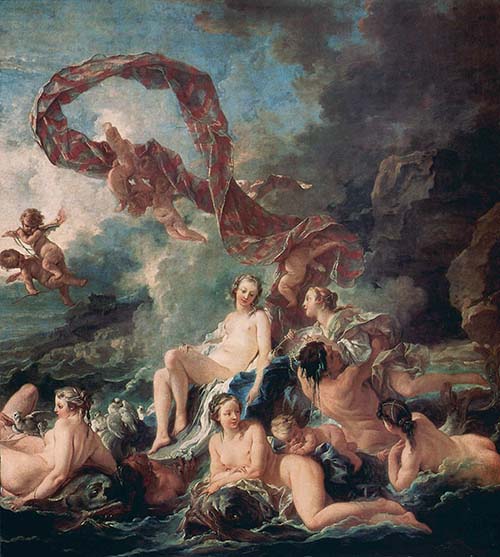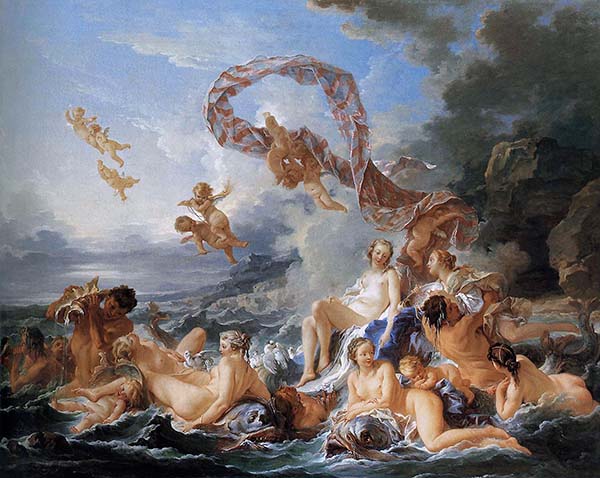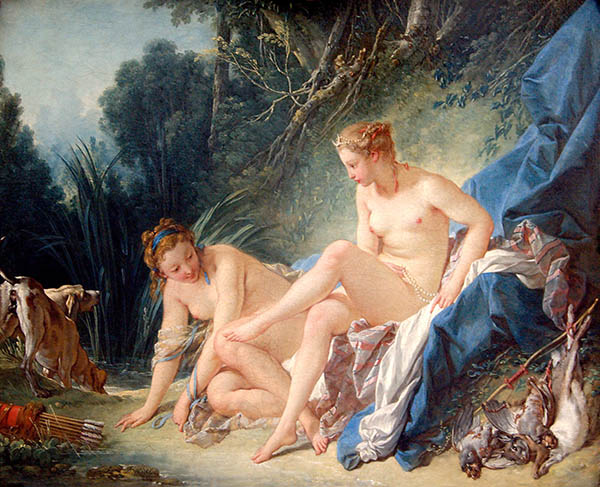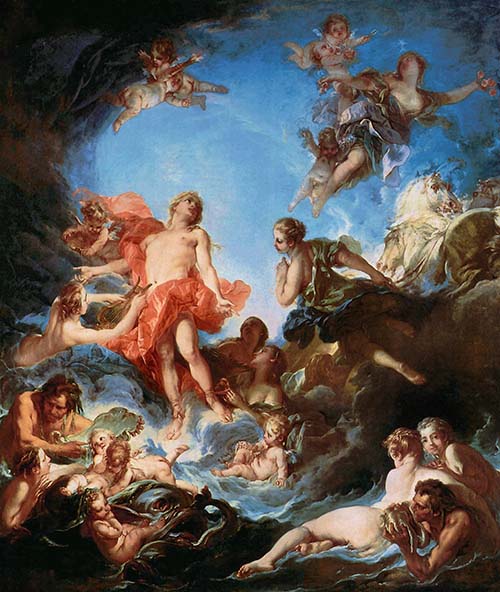Some Masterpieces from the Public Domain
Version 1.2, © 2009 by Dale Cotton, all rights reserved
Boucher
Warning: clotheslessness below.
Wikipedia entry for Boucher New World Encyclopedia entry for Boucher Humanities Web entry for Boucher
Once I got started exploring this problematic trove of public domain reproductions of the masters, I quickly became involved in exploring and turning up what for me are new gems. I never gave François Boucher (pronounced frahn-zwah boo-shay, no accented syllables) a moment's thought ere now. Through most of my life his superficial sensuality would have been off-putting; now I find I'm easily vanquished by the charms of his decadent delights. François' cheerful pallet and classical-mythology-inspired themes, contrast dramatically with Rembrandt's heavy darknesses and biblical stories. Reading up on on him in Wikipedia leads me straight to this absolutely incredible portrait:
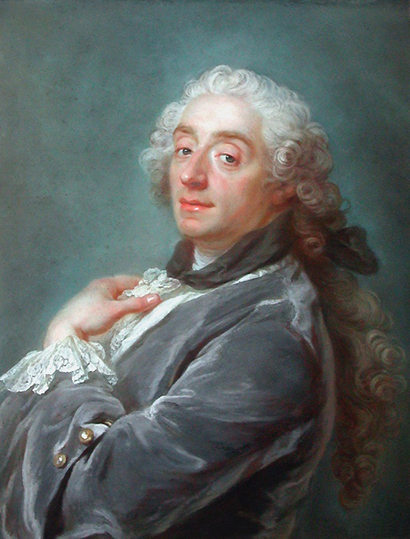
Fig. 6-1: Gustav Lundberg: François Boucher, 1741
Nothing could be more opposite the stilted stiffness of 99% of all posed portraits ever painted or photographed. Exactly the sort of thing I was looking for! But on to the downloads:
Science tells us skull size is remarkably consistent among adults; and I well remember coming across the fact at some point in my art education that the human figure is roughly six heads tall in a tall adult, five heads in a short adult, and three or four in a child. Now notice how small Venus' head is in proportion to her body in Fig. 6-2: she'd have to be at least seven or eight feet tall for that to be the case. Notice also how absurdly small Venus' feet are in proportion to her body; and we see the same thing in Diana's feet in the next painting. I vaguely recall this combination to be a trick first found in ancient Graeco-Roman art, the idea being to create a subliminal sense of grandeur or heroic proportions.
But these are mere details. Boucher's Venus, as well as her companions, has such an exquisitely sweet face that it's almost as though he had children pose as models for the faces, then adults pose for the bodies. We also have to note – since it's hardly avoidable – that Boucher's idea of the human female breast (with which he must have been intimately acquainted) is both modest and almost sexless. But more than that, it's decidedly peculiar, given their defiance of the law of gravity.
In fact, Boucher's nudes are very much opposite the erotic, being rather idealizations in the Graeco-Roman tradition. These are goddesses, not in the sense of beings with super powers, but in the sense of beings we might put on a pedestal and adore. And as soon as the word "adore" comes to mind, something clicks for me: perhaps the closest parallel to the sweetness of Boucher's females is the Mary in Michelangelo's Pieta. Boucher was very much a product of the sheltered world of the classical French court (Louis XV). This was an island of liberation within a vast sea of repressive/conservative Catholicism. I can imagine him very consciously deciding that if painters were going to take it upon themselves to defy the status quo by unclothing the human form, it was imperative in doing so that they remain beyond any reproach of mere carnality. (Unfortunately, by the end of François' life the storm clouds of societal darkness were once more amassing in preparation for the coming revolutions; and his paintings became a magnet for criticisms of the life style they evidenced.)
In working the Triumph I was troubled by the extremely muted dusty rose stripes in the waving cloth banner. This is just the sort of colour drop-out that can result from a mis-calibrated scanner. But if we glance down at the next painting, the cloth Diana is sitting upon is similarly coloured, and this is a reproduction we can trust. The flesh colours in the Triumph are also muted and less luminous than those in the Diana, but this is at least congruent with the implicit lighting and time of day.
I later discovered this second version of the Triumph. Here we see the full canvas, plus the colours are much clearer, suggesting to me that this the painting has been restored to remove oil-yellowing. Unfortunately, the JPEG we have here is too small to make a good print; if you print it at all, I'd suggest 8 x 10", or so:
Next is the sole painting in this set captured with a digital camera and clearly processed with considerable care for colour accuracy. If we didn't have this reproduction we'd be forced to live with something as depressing as this. Notice that Boucher has not just given us a pretty girl in the goddess Diana (figure on right) and her inseparable companion, Callisto. More than that he's captured that indefinable vacuity of expression we associate with extreme youth (again, I see children posing for their faces); and which belies the callous butchery implicit in her clutch of fresh corpses, bottom right. Diana is the huntress goddess in Roman mythology. The gods ate only ambrosia (and drank only nectar), so why would a goddess hunt? Surely our good M. Boucher asked himself this question, and the answer that seemed good to him is painted in her face.
Notice also the almost comic relief of the hunting dogs, juxtaposed in darker hues beside the delicate and bright pastels of the divines. The dogs and game corpses bracket the divines, as if to accentuate their etherealness. Boucher's flesh tones here are a rare treat in combining pastel pink and pastel amber to create a luminosity with no hint of deadness, and most of all no hint of the jaundiced ochre we so commonly see used for Caucasian flesh tones. Behold also the blue-green hues Boucher has used for the background trees. This is a colour we might expect for vegetation obscured by great distance. Wikipedia tells us "Boucher is famous for saying that the natural world was 'trop verte et mal eclaire' (too green and badly lit)". [Truly, a fellow spirit – I've long been on record railing against what I call the green plague of summer (not to mention the white plague of winter). ;)]
In the next image, we see almost every element in the picture has been personified. As we've already seen, if your name is Boucher (which grotesquely is the French word for butcher), any excuse to introduce an unclothed or scantily clothed human figure is a good excuse. ;) Rising sun? Surely a shapely young man. Morning star? Surely a shapely young woman.
About half Boucher's work were almost insufferably cute period pieces, which I suspect were cynically targeted at his audience and meant to put food on the table, are not represented here. As I said, Boucher's paintings are a new discovery for me and I'm still in the early stages of infatuation, I'm sure. But on reflection I realize his main appeal, beyond sheer artistry, is his irrepressible joie de vivre – a quality we see as much in his paintings as in the Lundberg portrait. A quality of which I'm entirely envious!
